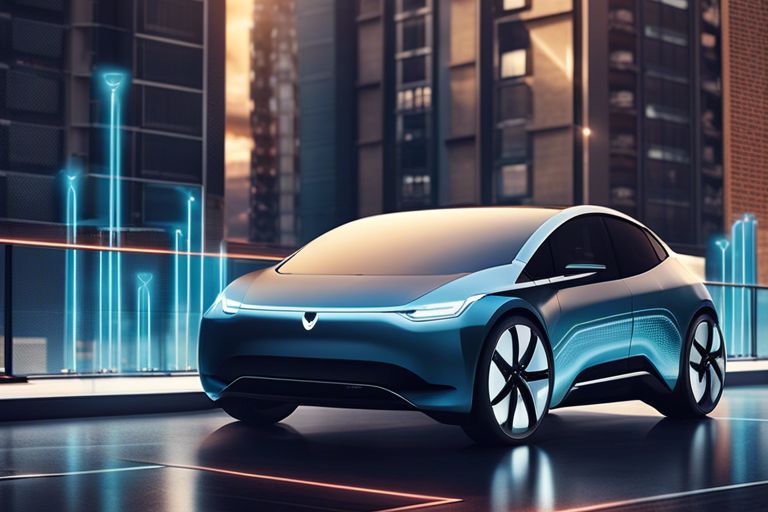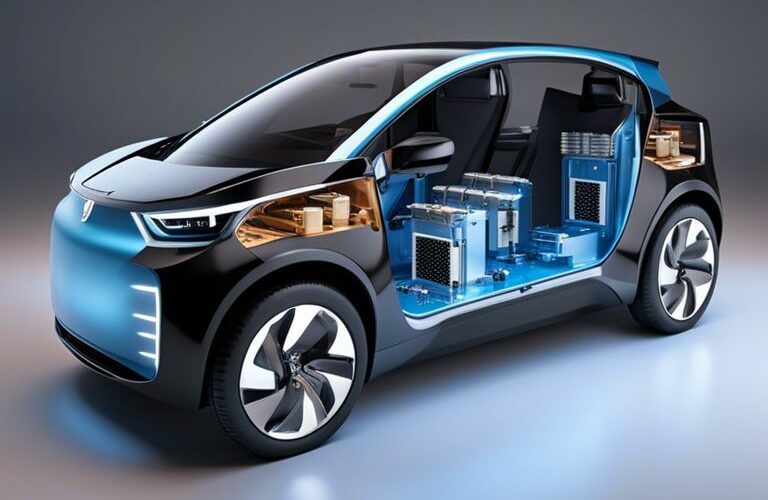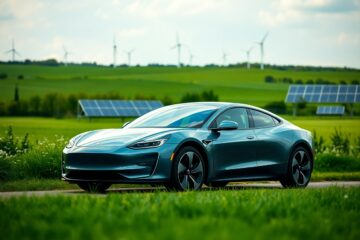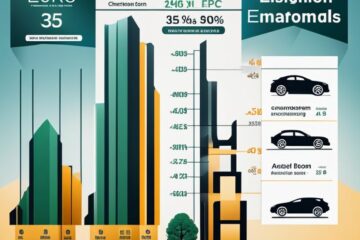Electric cars, or EVs, are vehicles powered by electric motors rather than internal combustion engines. This innovative technology relies on a large battery to store and dispatch electricity to the motor, which then propels the car forward. When the driver steps on the accelerator, the car draws power from the battery to spin the motor, driving the wheels. Unlike traditional gas-powered vehicles, electric cars produce zero tailpipe emissions, making them a cleaner and more sustainable transportation option.
While electric cars offer environmental benefits and lower fuel costs, there are also some challenges associated with them, including limited driving range and longer refueling times. Electric cars are rapidly gaining popularity as advancements in battery technology continue to improve their range and performance, making them a viable solution for a more sustainable future.
Table of Contents
The Components of an Electric Car
An electric car is made up of several key components that work together to power the vehicle. These components include the electric motor, battery packs, power electronics converter, onboard charging systems, and thermal management systems. Each of these components plays a crucial role in the functionality and performance of the electric car.
Electric Motor: The Heart of an Electric Car
With the rise of electric cars, the electric motor has become the heart of the vehicle. The electric motor is responsible for converting electrical energy from the battery into mechanical energy to drive the car. It works by using an electromagnetic field to produce a torque that rotates the motor shaft, resulting in the vehicle’s movement. The electric motor is a crucial component that sets electric cars apart from traditional internal combustion engine vehicles, offering efficiency, instant torque, and low maintenance.
Additionally, the electric motor eliminates the need for a traditional transmission system, simplifying the vehicle’s drivetrain and reducing the number of moving parts. This not only increases reliability and longevity, but also reduces the overall weight of the vehicle, contributing to improved energy efficiency and driving range.
Battery Packs: Storing the Energy
Any electric car requires a large, powerful battery pack to store the energy needed for operation. These battery packs are typically made up of numerous individual lithium-ion cells, which are connected in series to provide the necessary voltage and in parallel to increase the overall capacity. The battery management system ensures the safety, performance, and longevity of the battery pack by monitoring the cells and balancing their charge levels.
Electric cars rely on high-capacity battery packs to provide the necessary energy for driving, with advancements in battery technology leading to improved energy density and longer driving ranges. The development of solid-state batteries and other advanced energy storage solutions continues to drive the evolution and innovation surrounding electric car battery technology.
The Power Electronics Converter
Storing electrical energy in the battery pack requires a power electronics converter to manage the flow of energy between the battery and the electric motor. This component converts the direct current (DC) power from the battery into alternating current (AC) for the electric motor, as well as controls the charging process when the vehicle is plugged into a charging station. The power electronics converter plays a crucial role in ensuring efficient energy transfer and optimal performance of the electric vehicle.
Power electronics converters also incorporate features for regenerative braking, allowing the electric motor to act as a generator to recover energy during braking and store it back in the battery pack. This recycling of energy contributes to the overall efficiency and range of the electric car, highlighting the importance of the power electronics converter in the vehicle’s energy management system.
Onboard Charging Systems
An essential aspect of electric car technology is the onboard charging systems, which enable the vehicle to recharge its battery pack from an external power source. These systems include the charging port, onboard charger, and associated control electronics, allowing for convenient and efficient recharging at home or at public charging stations. The integration of fast-charging capabilities is an important advancement that reduces charging times and increases the practicality of electric vehicles.
Systems for wireless charging are also being developed to further simplify the recharging process, offering seamless integration with the daily routine of electric car owners. As the infrastructure for electric vehicle charging continues to expand, onboard charging systems play a critical role in supporting the widespread adoption and usability of electric cars.
Thermal Management Systems
Battery temperature is a critical factor in the performance and safety of electric vehicles, making thermal management systems essential for regulating the temperature of the battery pack. These systems use liquid or air cooling methods to maintain the battery within an optimal temperature range, ensuring longevity, reliability, and safety of the energy storage system.
It is important to manage the heat generated during charging and discharging processes in the battery pack to prevent thermal runaway and premature degradation. Advanced thermal management systems contribute to the overall efficiency and performance of electric cars, addressing the unique challenges associated with high-capacity battery packs in a vehicle environment.

Battery Technology
Keep up with the rapid advancements in battery technology is crucial for understanding how electric cars work. As the heart of an electric vehicle, the battery pack is responsible for storing and supplying the energy needed to power the vehicle’s electric motor.
Types of Electric Vehicle Batteries
There are several different types of batteries used in electric vehicles, each with its own unique characteristics and performance capabilities. The most common types of electric vehicle batteries include lithium-ion, nickel-metal hydride, and solid-state batteries. These batteries vary in terms of energy density, charging speed, and overall lifespan. Recognizing the differences between these battery types is essential for evaluating the performance and range of an electric vehicle.
- Lithium-ion: High energy density, fast charging, and lightweight
- Nickel-metal hydride: Reliable and stable performance, moderate energy density
- Solid-state: Potential for higher energy density and longer lifespan
- Recognizing the differences between these battery types is essential for evaluating the performance and range of an electric vehicle.
Charging and Range Considerations
Electric vehicle batteries require charging to replenish the energy used while driving. The charging infrastructure for electric vehicles continues to expand, offering a variety of charging options, including Level 1, Level 2, and DC fast charging. Understanding the charging capabilities and requirements of an electric vehicle is essential for planning and optimizing the driving range.
An electric vehicle’s driving range is determined by the battery capacity and driving conditions. Factors such as weather, driving speed, and accessory usage can impact the overall range of an electric vehicle. Charging and Range Considerations are important factors to consider when considering the practicality of electric vehicle ownership.
Advances in Battery Technology and Lifespan
For the electric vehicle industry, advances in battery technology are driving improvements in energy density, charging speed, and overall lifespan. These advancements are essential for enhancing the performance and capabilities of electric vehicles, ultimately making them more competitive with traditional internal combustion engine vehicles.
Types of lithium-ion batteries, including lithium iron phosphate (LiFePO4) and nickel cobalt manganese (NCM), are particularly noteworthy for their potential to improve the energy density and cycle life of electric vehicle batteries. These advancements are instrumental in the ongoing evolution of electric vehicle technology.
Electric Car Drivetrains
Your electric car’s drivetrain is the system responsible for transmitting power from the electric motor to the wheels. It is a critical component that determines the car’s performance, efficiency, and overall driving experience.
Understanding the Electric Drivetrain
On a fundamental level, the electric drivetrain consists of three main parts: the electric motor, power electronics, and the transmission. The electric motor is the heart of the drivetrain, converting electrical energy from the battery into mechanical energy to drive the vehicle. Power electronics manage the flow of electricity between the battery and the motor, while the transmission controls the distribution of power to the wheels. Together, these components work in harmony to deliver a smooth and efficient driving experience.
Comparison with Internal Combustion Engines
| Drivetrain Efficiency | Drivetrain Complexity |
| Electric Drivetrain | Internal Combustion Engine |
| Over 90% efficiency | Complex electric components |
This comparison highlights the superior efficiency of electric drivetrains, with over 90% of the energy from the battery being converted to propulsion, compared to the lower efficiency of internal combustion engines. Additionally, the electric drivetrain boasts lower complexity due to fewer moving parts and no need for complex gear systems.
Regenerative Braking Systems
On electric cars, regenerative braking systems capture the kinetic energy from braking and convert it back into electrical energy to recharge the battery. This innovative feature not only improves the car’s efficiency but also reduces wear on the brake components, resulting in longer-lasting and low-maintenance braking systems.
With regenerative braking systems, electric cars can harness energy that is typically wasted as heat in traditional braking systems, allowing for increased range and improved overall energy utilization. This advanced technology is a significant contributor to the sustainability and efficiency of electric drivetrains.
The Electric Vehicle Charging Infrastructure
To understand how electric cars work, it’s essential to comprehend the electric vehicle charging infrastructure that supports them. Electric vehicles (EVs) rely on a network of charging stations to power their batteries. There are various types of charging solutions available to EV owners, including home charging solutions, public charging stations, and multiple charging standards and connectors.
Home Charging Solutions
An essential component of the electric vehicle charging infrastructure is the availability of home charging solutions. These solutions provide EV owners with the convenience of charging their vehicles at home, eliminating the need for regular visits to public charging stations. This is typically achieved through the installation of a dedicated charging unit in the owner’s garage or driveway, allowing for overnight charging and ensuring the vehicle is always ready for use.
Another benefit of home charging solutions is the cost savings associated with charging an EV at home, as electricity prices are generally lower than public charging rates. Additionally, many electric utilities offer special rates and incentives for EV owners, further incentivizing the use of home charging solutions.
Public Charging Stations
Solutions for charging electric vehicles extend beyond the home, with a widespread network of public charging stations available to EV owners in urban and rural areas alike. Public charging stations provide a convenient option for recharging while on the go, offering different charging speeds to accommodate various driving needs. However, the availability and accessibility of public charging stations continue to be a crucial consideration for the widespread adoption of electric vehicles.
This includes the need for an expanded public charging infrastructure and enhanced interoperability between different charging networks. This is essential to address range anxiety and ensure that EV drivers have the confidence to travel longer distances without worrying about running out of battery.
Charging Standards and Connectors
One of the key aspects of the electric vehicle charging infrastructure is the existence of standardization in charging connectors and protocols. This streamlines the charging process and ensures compatibility between vehicles and charging stations. It also simplifies the EV ownership experience for consumers, providing a consistent and familiar means of charging their vehicles.
It is essential to have well-established charging standards in place to support the growth of the electric vehicle market, fostering competition and innovation in the development of charging infrastructure and technology. Standardization also plays a significant role in addressing concerns about safety and reliability in the charging process, building trust among consumers.
Environmental Impact
For many people, one of the most appealing aspects of electric cars is their potential to reduce the environmental impact of transportation. As the world grapples with the challenges of climate change and air pollution, the adoption of electric vehicles is seen as a crucial step towards a cleaner and more sustainable future.
Emissions and Air Quality
With zero tailpipe emissions, electric cars contribute to improved air quality, particularly in urban areas where conventional vehicles are a major source of pollution. The reduction in greenhouse gas emissions from electric vehicles also plays a significant role in combating climate change, as these vehicles help to lower the overall carbon footprint of the transportation sector.
With regenerative braking technology, electric cars are able to capture and store energy that is typically lost as heat during braking. This not only improves the efficiency of the vehicle, but also reduces the amount of particulate matter and nitrogen oxides released into the air, further benefiting air quality.
Life Cycle Analysis of Electric Cars
Electric vehicles are not immune to environmental impact, however. Electric car manufacturing involves the extraction and processing of raw materials, which can have environmental consequences. Additionally, the charging of electric vehicle batteries relies on the electricity grid, which in some regions may still be heavily reliant on fossil fuels.
To fully assess the environmental impact of electric cars, a comprehensive life cycle analysis is necessary. This approach takes into account the environmental effects of a vehicle throughout its entire life cycle, from manufacturing to use and eventual disposal. It considers factors such as energy consumption, emissions, and resource depletion, providing a more holistic understanding of the environmental implications of electric car adoption.
The Economics of Electric Cars
Not only are electric cars beneficial for the environment, but they also have a significant impact on the economics of the automotive industry. Understanding the financial aspects of electric vehicles is crucial for consumers considering a switch from traditional gasoline-powered cars.
Initial Cost and Incentives
Economics play a pivotal role in the decision to purchase an electric car. While the initial cost of an electric vehicle may be higher than that of a conventional car, various incentives and rebates provided by governments and local authorities can significantly offset this difference. Additionally, long-term savings on fuel and maintenance costs make electric cars a financially appealing option.
When considering the initial cost of an electric car, it’s important to take into account the incentives and rebates available in your region. These can considerably reduce the upfront investment required, making the transition to electric vehicles more accessible for consumers.
Running Costs and Maintenance
On top of the initial cost considerations, the running costs and maintenance of electric cars are also notable economic factors. Electric vehicles generally have lower operating expenses compared to traditional cars due to the lower cost of electricity versus gasoline, as well as reduced maintenance requirements owing to simpler drivetrains and fewer moving parts.
The long-term savings on fuel and maintenance costs are significant advantages of electric cars, making them an attractive option for consumers conscious of their financial bottom line over the lifespan of the vehicle.
The Future of Electric Vehicles
After decades of development and innovation, it is clear that electric vehicles are here to stay. With the growing demand for sustainable transportation solutions, the future of electric vehicles looks promising. Advancements in technology and the ever-increasing awareness of environmental concerns are driving the electric vehicle industry forward.
Technological Advancements on the Horizon
Technological advancements in the electric vehicle industry are constantly pushing the boundaries of what is possible. Future developments may include improved battery technology, allowing for longer ranges and faster charging times. Additionally, advancements in autonomous driving technology will further revolutionize the way we think about transportation. These developments will enhance the overall driving experience and contribute to the widespread adoption of electric vehicles.
Furthermore, developments in lightweight materials and aerodynamics will improve the overall performance and efficiency of electric vehicles. This will lead to longer battery life and increased energy efficiency, further cementing electric vehicles as a viable option for the future.
The Role of Electric Cars in the Future of Transportation
Electric vehicles will play a crucial role in the future of transportation. As the world seeks to reduce its carbon footprint, electric cars will be at the forefront of this transition. The integration of electric vehicles into the transportation network will significantly reduce greenhouse gas emissions and improve air quality in urban areas. This will positively impact public health and the environment for generations to come.
Furthermore, electric vehicles will play a key role in the shift towards smart and connected transportation systems. The implementation of electric vehicle infrastructure will strengthen the resilience and reliability of the transportation network. As a result, electric vehicles will contribute to a more sustainable and efficient future for transportation.
To wrap up
So, in conclusion, electric cars work by using electricity from rechargeable batteries to power an electric motor, which in turn drives the wheels. The batteries are recharged by plugging the car into an electric power source, making them a more sustainable and eco-friendly option compared to traditional gasoline-powered vehicles. The electric motor provides instant torque, resulting in fast acceleration and a smoother driving experience. As technology continues to advance, we can expect to see even more efficient and innovative electric car designs in the future.
FAQ
Q: How do electric cars work?
A: Electric cars are powered by electric motors, which are run by a rechargeable battery pack. The battery pack provides the necessary electricity to power the electric motor, which then propels the vehicle forward.
Q: What is the difference between electric cars and gasoline cars?
A: Electric cars use electric motors and rechargeable batteries to operate, while gasoline cars use internal combustion engines that run on gasoline or diesel fuel. Electric cars produce zero tailpipe emissions, while gasoline cars emit pollutants.
Q: How long does it take to charge an electric car?
A: The time it takes to charge an electric car can vary depending on the charging station and the car’s battery capacity. A typical home charger can fully charge an electric car in 8 to 12 hours, while fast chargers can charge a car to 80% in about 30 minutes.
Q: What is regenerative braking in electric cars?
A: Regenerative braking is a technology used in electric cars where the electric motor acts as a generator to convert some of the kinetic energy that would be lost as heat in traditional braking systems back into electricity, which is then used to recharge the car’s battery.
Q: Are electric cars more environmentally friendly than gasoline cars?
A: Yes, electric cars are more environmentally friendly than gasoline cars. They produce zero tailpipe emissions, which reduces air pollution and greenhouse gas emissions. Additionally, as the electricity grid becomes greener, the environmental benefits of electric cars will continue to improve.

Our contributing author is a passionate advocate for eco-friendly living and sustainability. With a background in eco-life, they are dedicated to inspiring and empowering individuals to adopt environmentally conscious lifestyles. Through insightful articles, they share practical tips, innovative solutions, and thought-provoking perspectives to promote a greener, more sustainable world. Join them on the journey towards eco-smart living and discover how small choices can make a big impact. 🌱









